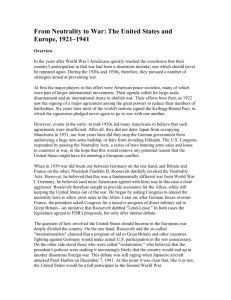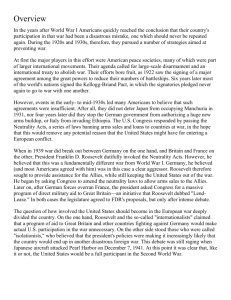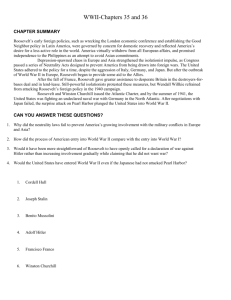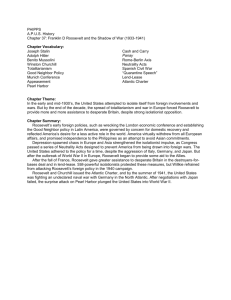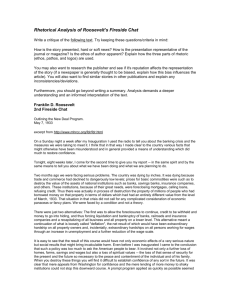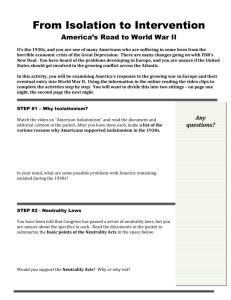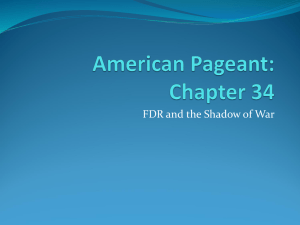clinging to isolationism - americanhistoryrules.com
advertisement
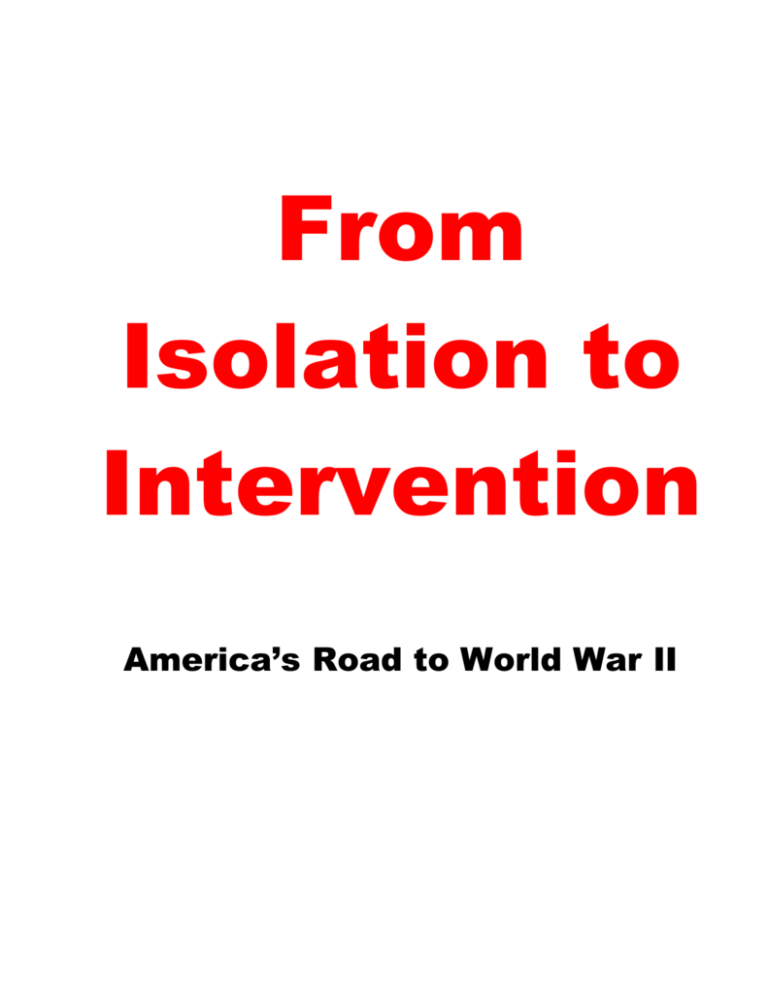
From Isolation to Intervention America’s Road to World War II STEP #1 - Why Isolationism? During the Great Depression, isolationist sentiment surged. In 1935, 150,000 college students participated in a nationwide Student Strike for Peace and half a million signed pledges saying that they would refuse to serve in event of war. A public opinion poll indicated that 39 percent of college students would refuse to participate in any war, even if the country was invaded. Anti-war sentiment was not confined to undergraduates. Disillusionment over World War I fed opposition to foreign entanglements. "We didn't win a thing we set out for in the last war," said Senator Gerald Nye of North Dakota. "We merely succeeded, with tremendous loss of life, to make secure the loans of private bankers to the Allies." The overwhelming majority of Americans agreed; an opinion poll in 1935 found that 70 percent of Americans believed that intervention in World War I had been a mistake. Isolationist ideas spread through American popular culture during the mid 1930s. The Book of the Month Club featured a volume entitled Merchants of Death, which contended that the United States had been drawn into the European war by international arms manufacturers, who had deliberately fomented conflict in order to market their products. From 1934 to 1936, a congressional committee chaired by Senator Nye investigated charges that false Allied propaganda and unscrupulous Wall Street bankers had dragged Americans into the European war. In April 1935--the eighteenth anniversary of American entry into World War I--50,000 veterans held a peace march in Washington, D.C. STEP #2 - Neutrality Laws While hostilities were building in Europe and the Far East, the U.S. Congress passed three pieces of legislation-- known collectively as the Neutrality Acts--designed to keep America out of war. Congress was determined to avoid the mistakes which had drawn America into the First World War. Between 1935 and 1937, Congress passed three separate neutrality laws that clamped an embargo on arms sales to belligerents, forbade American ships from entering war zones and prohibited them from being armed, and barred Americans from traveling on belligerent ships. The acts made no distinction between which country was an aggressor and which country was a victim. Clearly, Congress was determined not to repeat what it regarded as the mistakes that had plunged the United States into World War I. The leadership for neutrality in the Senate was Robert A. Taft, who (along with others) pushed for three neutrality laws. The Neutrality Act of 1935 prohibited shipment of American weapons to any belligerent nation (that is, any nation at war). Against the wishes of FDR, this act did not differentiate between "the good guys and the bad guys"--nations defending themselves and nations on the attack. The Second Neutrality Act of 1936 forbade American loans to any belligerent nation, again, without distinguishing between aggressors and victims. The Third Neutrality Act of 1937 made the two previous laws a permanent part of American national policy and it forbade U.S. citizens to travel on ocean-going vessels of nations at war. This was clearly designed to prevent another incident like the sinking of the Lusitania, a British passenger ship with Americans aboard that was torpedoed by Germany in WWI. STEP #3 Building America’s Defense By the late 1930s, Roosevelt asked Congress to increase spending for national defense. After years of isolationism, the United States was militarily weak. Critics pointed out that 18 countries had larger armies, the navy could hardly protect the Panama Canal, and that Italy's air force had more firepower than that of the United States. The U.S. government's first effort to begin preparations for war came with the creation of the War Resources Board (WRB). The board was to produce a plan identifying what would be needed to mobilize the nation's industries. Also in 1939, the military released its own Industrial Mobilization Plan. Following the fall of France in June 1940 and the beginning of a German air assault on Britain later that summer, Roosevelt brought back the National Defense Advisory Commission (NDAC). The NDAC had previously existed during World War I (1914–1918). The commission was composed of members representing labor, agriculture, industry, and public consumers. Roosevelt was still facing an isolationist Congress and public, and an industry not eager to shift its focus from consumer goods to war materials. Roosevelt believed the NDAC could better overcome these hurdles than he could acting alone. Congress significantly boosted defense spending in 1940 and passed the first peacetime military draft for the United States. The commission, however, had little authority except to advise what action it thought was needed. Mobilization continued to progress slowly. Despite these planning efforts, little translated into actual action and few new jobs resulted. It also passed the nation's first peacetime military draft. Under the Selective Training and Service Act, 16 million men between the ages of 21 and 35 were registered. Of these, 1 million were to be drafted for one year. Roosevelt himself drew the first draft numbers. "This is a most solemn ceremony," he told a national radio audience. "It is accompanied by no fanfare - no blowing of bugles or beating of drums. There should be none." With each step Roosevelt took against the Axis powers, the roar of the isolationists grew louder. In August 1941, they voiced their opposition to a bill to extend the draft for another 18 months. Congress passed the draft-extension bill, but only by a razor-thin margin of 203 to 202 in the House of Representatives. STEP #4 – Cash and Carry In the spring of 1939, Germany, Japan, and Italy continue militaristic policies and expansion. President Roosevelt wants more flexibility to meet the challenges in both hemispheres, so he suggested amending the Neutrality Acts to allow warring nations to purchase munitions if they paid cash and transported the goods on non-American ships. This policy, called “Cash and Carry”, obviously favors Britain and France. Roosevelt feels that the best way to keep America out of the war is by providing the arms to help France and Britain defeat Hitler. Senator George W. Norris agrees, stating “If we repeal it, we are helping England and France. If we fail to repeal it, we will be helping Hitler and his allies. Absolute neutrality is an impossibility.” Isolationists in Congress, such as Senator Arthur Vandenberg, argued just the opposite, however. "I do not believe that we can become an arsenal for one belligerent without becoming a target for another," Vandenberg said. Supporters on both sides of the neutrality issue are lobbying Congress with great intensity. Congressional offices have received hundreds of letters, postcards, and petitions promoting their position. One postcard evokes isolationist arguments that war was supported by wealthy industrialists. A second recalls George Washington’s admonition that the United States should avoid entangling itself in European affairs. The third backs the "cash and carry" idea arguing that selling munitions to Britain and France will make it less likely that Americans will become directly involved in war. Transcription Nov 2, 1939 Mr. Sol Bloom Please do not vote for repeal of the embargo also don’t send our boys to war on foreign soil. Remember the words of George Washington and bless his memory. I have a 21 year old son. Mr. M. Carew 2002 W. 103 St, NewYork City Originally, Congress did not pass the bill. Once Germany invaded Poland, however, Congress reconsidered. After six weeks of heated debate, Congress passed the Neutrality Act of 1939, and cash- and-carry went into effect. The passage of the 1939 Neutrality Act marked the beginning of a congressional shift away from isolationism. Information and images from “Congress, Neutrality, and Lend Lease”. Treasures of Congress. 2000. The Library of Congress. 17 April 2006 < http://www.archives.gov/exhibits/treasures_of_congress/page_20.html> STEP #5 – The America First Committee The America First Committee (AFC) was organized in July 1940 to oppose America's potential intervention in World War II. Spokesman Charles A. Lindbergh argued that the only way to save the country was to stay out of a tragic war in Europe and concentrate on defending America's way of life. The AFC strongly opposed President Franklin D. Roosevelt, as well as his New Deal. Soon after it was founded, the AFC became the most powerful isolationist group in the U.S. The AFC had four main principles: The United States must build an invulnerable national defense No foreign power, nor group of powers, can successfully attack an America that is prepared American democracy can be preserved only by keeping out of the war in Europe "Aid short of war" weakens national defense at home and threatens to involve America in war abroad. The AFC influenced the public's opinion through various publications and speeches. Membership was strong, particularly in the Midwest. Within a year the organization had more 800,000 members. The AFC strongly opposed the Lend Lease Act, which in their mind compromised America's neutrality. American First Committee, http://www.u-shistory.com/pages/h1643.html In a speech in Des Moines, Iowa, Charles A. Lindbergh claimed that the "three most important groups who have been pressing this country toward war are the British, the Jewish and the Roosevelt administration". Soon afterwards Senator Gerald Nye argued "that the Jewish people are a large factor in our movement toward war." These speeches resulted in some people claiming that the America First Committee was anti-Semitic. http://www.spartacus.schoolnet.co.uk/USAfirstC.htm Some people opposed the AFC and Lindbergh: STEP #6 – The Election of 1940 It’s 1940, and the Democratic Party has decided to nominate FDR for an unprecedented third term. He felt that it was necessary to provide continuity while American security was threatened, although we were not yet in the World War. Publicly, Roosevelt stated and restated his promise not to get the U.S. involved in the European war. He said “I hate war now more than ever. I have one supreme determination: to do all that I can to keep war away from these shores for all time." On another occasion during that campaign, FDR said: "I have said this before, but I shall say it again and again and again. Your boys are not going to be sent to any foreign war." Republicans chose Wendell L. Willkie, a corporate lawyer and president of a utility company, who had been a fierce critic of FDR's New Deal policies. Above all, Willkie was an internationalist, whose nomination signaled the triumph of those wanting the U.S. to play a major role in the world, against the party's isolationist wing. His nomination meant that FDR's preparedness program for the World War would not be subject to criticism during the campaign, which was fought on domestic issues. http://en.wikipedia.org/wiki/Image:ElectoralCollege1940-Large.png Both Willkie and Roosevelt promised to keep the nation out of war. Because there was so little difference between the candidates, the majority of voters chose the one they knew best. Roosevelt was reelected with nearly 55 percent of the votes cast. While FDR won 55 percent of the popular vote and the electoral votes of thirty-eight states, Willkie gained only ten states. But for Republicans this was an improvement over their dismal showing in 1936. Mainly, Roosevelt won because his New Deal program remained popular, and because the nation had confidence in his leadership during trying times. STEP #7 - The Arsenal of Democracy "H.R. 1776, A Bill Further to promote the defense of the United States and for other purposes." January 10, 1941 National Archives and Records Administration, Records of the U.S. House of Representatives By late 1940 Great Britain was increasingly unable to pay for and transport the war materials it needed in its fight against Nazi Germany. Britain’s Prime Minister Winston Churchill appealed to President Roosevelt to find a way for the United States to continue to aid Britain. FDR proposed providing war materials to Britain without the immediate payment called for in the Neutrality Act. A bill, assigned the patriotic bill number "1776," was introduced in the House on January 10, 1941, by Representative John McCormack of Massachusetts. After extensive hearings and debate, Congress passed "Lend-Lease" and President Roosevelt signed the Act on March 11, 1941. After the United States entered the war, Lend-Lease became the most important means for supplying the Allies with military aid. http://www.archives.gov/exhibits/treasures_of_congress/page_20.html# To explain the Lend-Lease Act to Americans, FDR used an analogy of a garden hose … Well, let me give you an illustration: Suppose my neighbor's home catches fire, and I have a length of garden hose 400 or 500 feet away. If he can take my garden hose and connect it up with his hydrant, I may help him to put out his fire. Now, what do I do? I don't say to him before that operation, "Neighbor, my garden hose cost me $15; you have to pay me $15 for it." What is the transaction that goes on? I don't want $15 - I want my garden hose back after the fire is over. All right. If it goes through the fire all right, intact, without any damage to it, he gives it back to me and thanks me very much for the use of it. But suppose it gets smashed up - holes in it - during the fire; we don't have to have too much formality about it, but I say to him, "I was glad to lend you that hose; I see I can't use it any more, it's all smashed up." He says, "How many feet of it were there?" I tell him, "There were 150 feet of it." He says, "All right, I will replace it." Now, if I get a nice garden hose back, I am in pretty good shape. In other words, if you lend certain munitions and get the munitions back at the end of the war, if they are intact - haven't been hurt - you are all right; if they have been damaged or have deteriorated or have been lost completely, it seems to me you come out pretty well if you have them replaced by the fellow to whom you have lent them. How did American material get to the Allies? Check out the routes on the map above. http://www.pbs.org/behindcloseddoors/tmp_assets/supplying-1.png The Lend-Lease program was stunningly successful in getting much-needed supplies to the Allies and keeping them in the war. In 1941 alone, more than 1,000,000 tons of food was shipped overseas. Great Britain received almost $700,000,000 worth of goods including munitions, raw materials, tools, fire-fighting equipment, food, vitamins for children, medical supplies, and tractors in just the first three months of 1943. From 1942 to September 1945, the Soviet Union received 9,000 tanks or self-propelled guns, 362,000 trucks, 47,000 jeeps, 131,633 submachine guns, 3,000 rocket launchers, 14,000,000 boots, 532,000 tons of U.S. sugar, 485,000 tons of canned meat (i.e., Spam) and hundreds of other items. Twenty percent of the Lend-Lease supplies the Soviets received was military, while the rest were food, metals, chemicals, petroleum products, and factory machinery. In all, from March 1941 to July 1946, the program cost the United States almost $51 billion, with the majority going to the British Empire ($31 billion), the Soviet Union ($11 billion), Free France and its possessions ($3.2 billion), China ($1.5 billion), and Brazil ($322 million). The U.S. also received billions of dollars worth of goods through reverse lendlease, including several hundred million dollars’ worth of food and supplies from Australia and New Zealand for American troops. http://www.pbs.org/behindcloseddoors/in-depth/supplying-allies.html First shipment of American lend-lease food arrives in Great Britain, 1941 STEP #8 - The Atlantic Charter The Atlantic Charter was negotiated at the Atlantic Conference (codenamed RIVIERA) by British Prime Minister Winston Churchill and U.S. President Franklin D. Roosevelt, aboard warships in a secure anchorage near Newfoundland. At the August, 1941 conference, Churchill had come hoping for a military commitment from the United States in their war against Germany. Instead, he settled for a declaration of principles called the Atlantic Charter. In this document, the two leaders spelled out the causes for which World War II was fought--even before the United States officially entered the conflict. The two sides also agreed to a series of goals that would foster international peace and security. The leaders pledged in this statement to work towards a postwar world that upheld the principles of self-governance and freedom for every country. The charter pledged both Great Britain and the United States to (1) seek no territorial expansion (2) pursue no territorial changes without the consent of the inhabitants (3) respect the right of people to choose their own form of government (4) promote free trade among nations (5) encourage international cooperation to improve peoples' lives (6) build a secure peace based on freedom from want and fear (7) work for disarmament of aggressors (8) establish a "permanent system of general security." Although it was neither an alliance nor a binding legal commitment, the agreement articulated the shared goals of Britain and the United States to end territorial aggression and war around the world. By the end of the following month, 15 other countries, all opposed to Nazi Germany, had signed the Atlantic Charter as well. The agreement will set the stage for a large alliance, should the United States enter the war in Europe. STEP #9 – Trouble with Japan Japanese expansion in East Asia began in 1931 with the invasion of Manchuria and continued in 1937 with a brutal attack on China. In September 1940, Japan occupied northern Indochina and later signed the Tripartite Pact with Germany and Italy, thus entering the military alliance known as the "Axis." Seeking to curb Japanese aggression and force a withdrawal of Japanese forces from Manchuria and China, the United States imposed economic sanctions on Japan. The United States prohibited the export of steel, scrap iron, and aviation gasoline to Japan. Roosevelt also approved a loan of $100 million to the Nationalist Chinese under the provisions of the Lend-Lease Act to combat Japanese aggression. Not quite a year later, in July 1941, Japan occupied southern Indochina. This time, Britain and the Netherlands joined the United States' protest by freezing Japanese assets. That meant that Japan was prevented from purchasing the oil needed to fuel its army, navy, and air force. Still, Japan was determined to carve out a new empire. Faced with severe shortages of oil and other natural resources and driven by the ambition to displace the United States as the dominant Pacific power, Japan decided to attack the United States and British forces in Asia and seize the resources of Southeast Asia. On December 1, 1941, Japan's premier Hideki Tojo concluded, "Japan has no other way than to wage war . . . to secure its existence and self-defense." On Sunday, December 7, Japan attacked American military installations in Hawaii, trying to cripple the US Pacific fleet and set the stage for their dominance in the Pacific.
